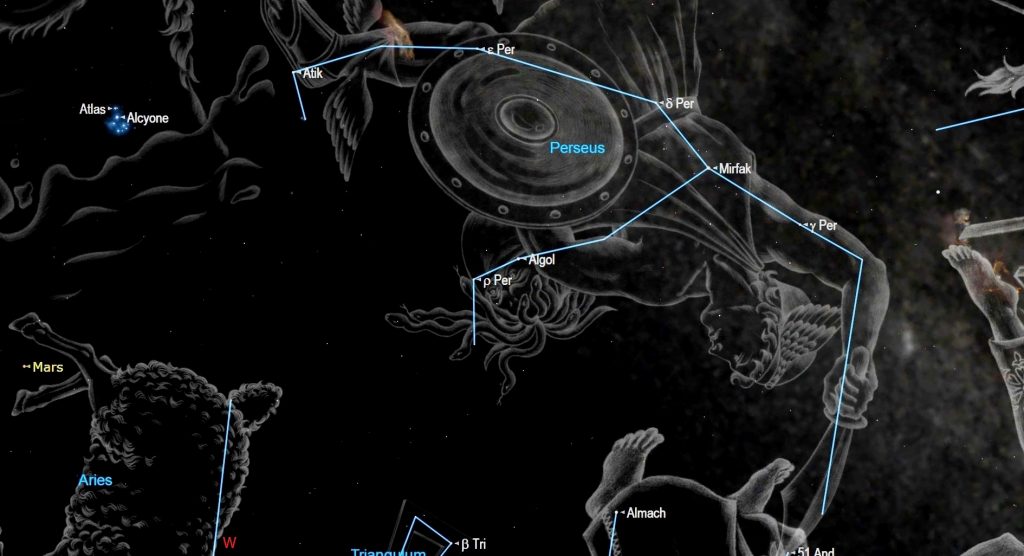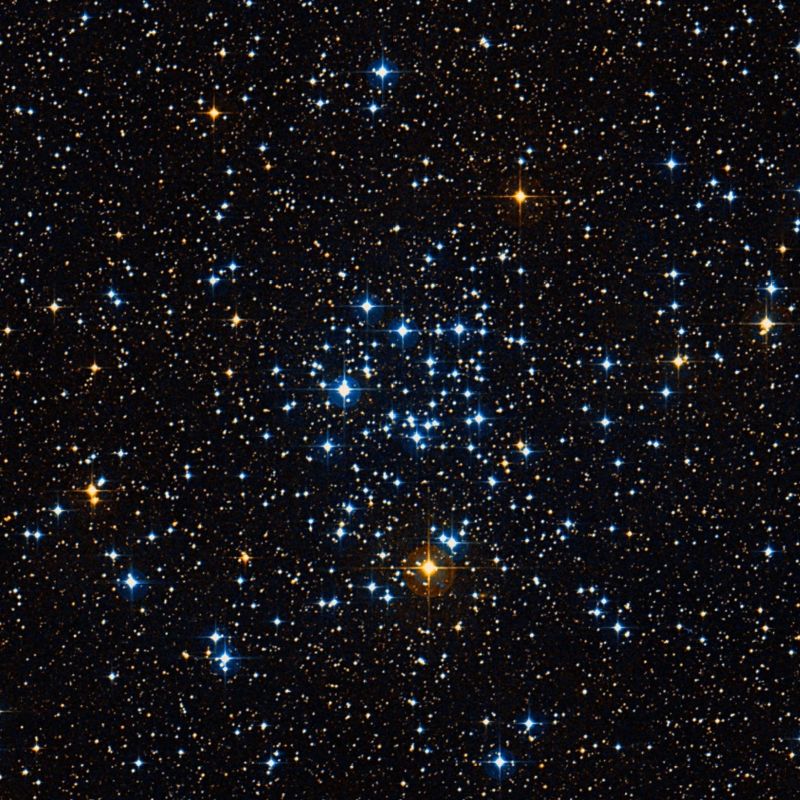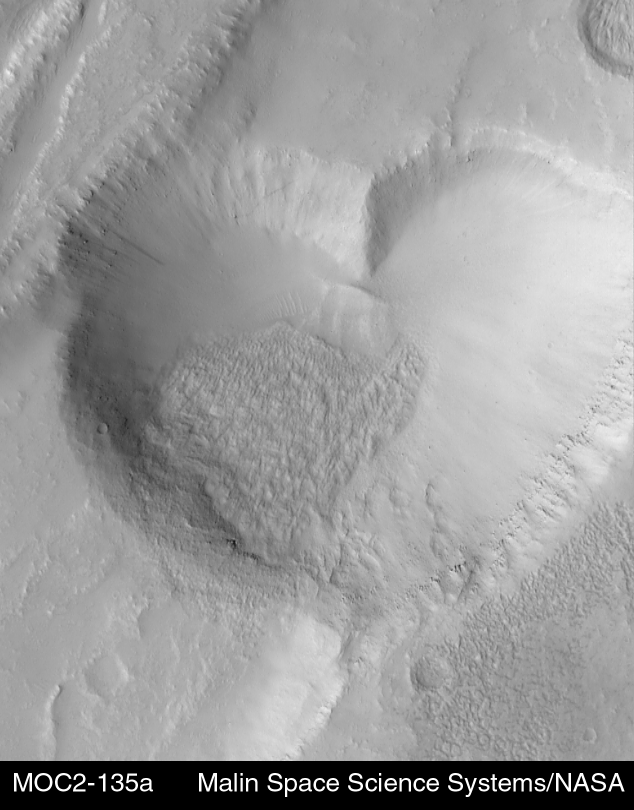An Old Moon Joins the Pre-dawn Planet Group, and Some Sweet Sights for Valentine’s Night!

This gorgeous patch of sky spans 6 by 11 degrees, or about a palm’s width by a fist’s diameter, held at arm’s length. The red nebulas at right are the Heart and Soul (IC 1805 and IC 1848) in Cassiopeia, 2500 light-years distant. The two bright star groups at left, in next-door Perseus, is collectively called the Double Cluster (NGC 884 and 869). This is a binoculars view with the zenith up and the ground down. Celestial north is towards the right. Happy Valentine’s Day night! (Stellarium screen cap.)
Hello, Star Lovers!
Here are your Astronomy Skylights for the week of February 7th, 2021 by Chris Vaughan. Feel free to pass this along to your friends and send me your comments, questions, and suggested topics. You can also follow me on Twitter as @astrogeoguy! Unless otherwise noted, all times are expressed in Eastern Time. To subscribe to these emails please click this MailChimp link.
I can bring my Digital Starlab portable inflatable planetarium to your school or other daytime or evening event, or teach a session online. Contact me through AstroGeo.ca, and we’ll tour the Universe, or the Earth’s interior, together!
The old waning crescent moon will visit all the planets that are gathered in the pre-dawn sky this week – leaving our nights dark for enjoying some Valentine’s treats. Meanwhile, Mars and Uranus shine in evening, Algol dims on Friday evening, and the Zodiacal Light glows after dark. Read on for your Skylights!
Evening Zodiacal light
If you live in a location where the sky is free of light pollution, then for about half an hour after full dusk between tonight (Sunday) and the new moon on Thursday, look in the western sky for a broad wedge of faint light extending upwards from the horizon and centered on the ecliptic. That glow is the zodiacal light – sunlight scattered from countless small particles of material that are sprinkled throughout the plane of our solar system. Try to observe the zodiacal light from a location without light pollution, and don’t confuse it with the brighter Milky Way, which extends upwards from the north-northwestern evening horizon at this time of year. I posted a nice photo of the phenomenon here.
Watch Medusa’s Eye Pulse
Algol, also designated Beta Persei, is among the most accessible variable stars for skywatchers. This star has been known to vary in brightness since antiquity – so the ancient Greeks decided that it represented the pulsing eye of Medusa the Gorgon, whose severed head is being held aloft by Perseus (the Hero).
During a ten-hour period that repeats reliably every 2 days, 20 hours, and 49 minutes, Algol’s visual brightness dims and re-brightens noticeably. This happens because a companion star orbiting nearly edge-on to Earth crosses in front of the much brighter main star, reducing the total light output we receive. This is known as an eclipsing binary system.
You can use nearby stars to judge Algol’s brightness. Algol normally shines at magnitude 2.1, similar to the star Almach (aka Gamma Andromedae), which is located a generous fist’s diameter to Algol’s lower right (or 12 degrees to the celestial west). But when it has fully dimmed, Algol’s brightness of magnitude 3.4 is almost identical to Rho Persei (or Gorgonea Tertia or ρ Per). That star sits just two finger widths to Algol’s lower left (or 2.25 degrees to the celestial south).

On Friday, February 12 at 7:25 pm EST, Algol will arrive at its minimum brightness while sitting fairly high in the western sky. (Start by locating the very bright star Mirfak sitting a fist’s diameter to Algol’s upper right.) Five hours later, at 12:25 am EST Algol will have brightened to its usual magnitude and it will be positioned 22 degrees above the northwestern horizon.
The Moon
The moon will be spending most of this week approaching the sun in the eastern pre-dawn sky. After passing the sun on Thursday, it will return to view in the western post-sunset sky on the coming weekend. Its absence from the evening sky will provide observers all around the world deliciously dark nights. (More on this below.)
On Monday morning the delicate crescent of the old waning moon will shine above the southeastern horizon among the stars of the Teapot asterism in Sagittarius (the Archer) – but you’ll need to view the picturesque scene before the sky begins to brighten at about 6:15 am local time.
On Tuesday morning, the moon won’t rise until the sky is brightening – but you might be able to spot the faint dot of Saturn shining about two palm widths to the lower left (or 14° to the celestial east) of the moon after Saturn rises at 6:50 am local time. By about 7:15 am, look for the bright planet Venus shining nearly two fist diameters to the moon’s lower left, or 17° to its celestial east. If you catch sight of Venus, see if you can pick out somewhat fainter Jupiter sitting just two finger widths to Venus’ lower left.
On Wednesday morning, those planets will still be there, and the moon will jump more than a fist’s diameter sunward – placing it a palm’s width to the right of Venus-Jupiter and below Saturn. These meet-ups will be much easier to see if you live at a southerly latitude, where the morning ecliptic will be more upright – allowing the moon and those planets to rise well before the sun.

Wednesday morning will be our last glimpse of the moon before it reaches its new moon phase at 2:05 pm EST on Thursday, February 11. (That’s 19:05 Greenwich Mean Time.) While new, the moon is travelling between Earth and the sun. Since sunlight can only reach the far side of the moon, and the moon is in the same region of the sky as the sun, the moon becomes completely hidden from view for about a day.
After new moon Earth’s planetary partner will return to shine in the southwestern evening sky after sunset on Friday. Observers living near the Great Lakes can look for an extremely thin crescent moon, only 1.5% of it illuminated (along its lower right edge), sitting very low over the horizon between about 5:45 and 6 pm local time. The moon will wax a little fuller, and climb a little higher, on Saturday and Sunday – making a lovely sight and photo opportunity during a romantic, socially-distanced stroll on Valentine’s Day.
The Planets
As I alluded to above, nearly all of the bright planets are gathered near the sun in the eastern pre-dawn sky nowadays – leaving only Mars and Uranus as viable evening observing targets. While this could technically be called a “planetary alignment”, they won’t align into a distinctive shape – and only Mercury is closer to us than the sun. The rest are arrayed on the far side of the solar system. These groupings are not particularly rare.
Venus is rapidly swinging sunward now – so its passage close below Jupiter will only last from Wednesday to Friday. Meanwhile, Jupiter and Saturn will rise about four minutes earlier each morning – allowing them to slowly escape the dawn twilight as we approach spring. They’ll spend 2021 much farther apart than they were in 2020.

This week, Mercury will be traveling west just a few finger widths above the Venus-Jupiter-Saturn grouping – but the speedy little planet will be too faint to easily see with unaided eyes. It will brighten a little every morning, and it will become more visible next week. Be sure that the sun has completely disappeared below the horizon before you search for the morning planets with binoculars.
Mars is still available for evening viewing between dusk and almost midnight every night, but it has been getting fainter, and smaller in telescopes, with each passing week. The medium-bright, reddish dot of Mars will be located two-thirds of the way up the southern sky at dusk. Then it will descend all evening and set at about 1:30 am local time. The bright star Aldebaran in Taurus (the Bull), which will sit about two fist diameters to Mars’ upper left (or 24° to the celestial southeast) this week, will appear about as bright and as red as Mars. The bright little Pleiades star cluster will sit above and between Mars and Aldebaran.
Tonight, February 7, dim and distant Uranus will be located nearly a fist’s diameter to the lower right of Mars. By next Sunday, that gap will increase to two palm widths, due to Mars’ faster orbital speed. Use the two brightest stars of Aries (the Ram), which will be sitting to the upper right (10 degrees to the celestial north) of Uranus, to help you locate the magnitude 5.8 planet. Hamal is brighter, at magnitude 2.0, and Sheratan is a bit fainter at magnitude 2.6.
View Uranus earlier in the evening when it’s higher in the sky and seen through less of Earth’s distorting atmosphere. In a telescope, Uranus will resemble the stars near it – but the planet won’t twinkle as much as they do, and it will show a blue-green colour. Sharp-eyes might be able to see Uranus without aid under a very dark sky. Binoculars will show it easily.
Valentine’s Night Treats
While none of the official constellations are heart-shaped, there are some romantic duos in the stars that you can see with your unaided eyes on Valentine’s Day night. I’ve also got a few delightful Valentine’s-themed clusters and nebulas for your enjoyment – and even some heart-shaped craters on Mars!

If you look about halfway up the western sky during mid-evening you’ll see the stars of Princess Andromeda extending upwards from the top corner of the big square of Pegasus. Andromeda’s hero, and eventual husband, Perseus is the constellation directly above her. Its centre is marked by the bright star Mirfak. Between those lovers, and a few fist diameters to their right (or 30° to the celestial northwest of them), are her parents’ constellations, w-shaped Queen Cassiopeia and King Cepheus. I told their story here.
To celebrate fraternal love, we have the constellation of Gemini (the Twins) located in the evening sky to the upper left (or celestial northeast) of Orion (the Hunter). The two medium-bright stars Pollux (on the lower left) and Castor (on the upper right) mark the heads of the two brothers. Note that Pollux is a wee bit brighter and warmer in colour than Castor. Viewed through your telescope, Castor splits into a nice double star.

For a different type of devotion, we can highlight hunter Orion’s faithful companion Canis Major (the Big Dog). Canis Major forever and faithfully follows his master around the sky – although he might be more interested in chasing Lepus (the Hare), the constellation that sits to his west, below Orion. The big dog’s stars are distributed around their brightest member, Sirius, also known as the Dog Star and Alpha Canis Majoris. On mid-February evenings, Sirius reaches its highest point over the southern horizon at around 9:30 pm local time – while sparkling like a diamond! Sirius is a hot, white, A-class star located only 8.6 light-years from Earth – part of the reason for its brilliance. For mid-northern latitude observers, Sirius is always seen in the lower third of the sky, through a thicker blanket of refracting atmosphere. This causes the strong twinkling and flashes of color the Dog Star is known for.
Look less than a finger’s width to the lower right of the bright star Alnitak – the star at the eastern, left-hand end of Orion’s Belt – for a medium-bright star named Sigma Orionis or σ Ori. When viewed in powerful binoculars or a backyard telescope, you’ll see that Sigma Orionis is in the middle of a pretty little group of about 10 stars arranged in a dart shape – like Cupid’s Arrow!

Beside Orion, on his eastern (left) side, and above Canis Major, is the constellation of Monoceros (the Unicorn). Its stars are mainly of medium and low brightness, but it sits squarely astride the Milky Way and contains some delightful sights! The Rosette Nebula (also known as NGC 2244) is a beautiful rose-shaped cloud of reddish gas with a clump of bright little stars in its centre. It is located about a fist’s diameter to the left of Orion’s shoulder star Betelgeuse. The Rosette is visible in binoculars, but only long-exposure photos will reveals its colourful rose.
A little star named Theta Canis Majoris sits a palm’s width to the upper left of Sirius. It marks the doggy’s nose! If you draw an imaginary line from Sirius to Theta and then double its length, you’ll come to a small open star cluster named Messier 50, also known as the Heart-Shaped Cluster and NGC 2323. The cluster is visible in binoculars – but try viewing it through your telescope. I don’t think that the heart shape is all that obvious – but the cluster of mainly white stars features the special treat of a bright, golden star at its lower edge.

Cassiopeia (the Queen) hosts the Heart Nebula, also known as the Valentine Nebula and IC 1805. It’s a truly beautiful object located 2,500 light-years away from us. This nebula and its companion the Soul Nebula (IC 1848) are located between Perseus and Cassiopeia – about three finger widths to the right of the Double Cluster. It’s too faint to see unless the sky is very, very dark – but many lovely photographs of it have been published. A faint, but rich star cluster named Caroline’s Rose (NGC 7789), named for female astronomer Caroline Herschel, sits a few degrees below the bottom stars of Cassiopeia.
The high-resolution camera on the Mars Global Surveyor orbiter has captured the surface of Mars in great detail. Here and here are some Valentine’s hearts we’ve found on the Red Planet. Other love-themed solar system objects include the main belt asteroids (433) Eros and (477) Valentine.

NASA has some space-themed Valentine’s Day cards you can share here.
Finally, to celebrate your favorite someone, locate and view their Birthday Star. That’s a star that is located at the same distance from Earth (expressed in light-years) as that person’s age in years. In other words, the light you see now started its journey towards us at the time they were born. Visit this page and scroll down the list to find birthday stars for different years old – or use this page to enter a birth date. Then you can look for that star in the night sky – if it happens to be visible at this time of year from your location. It’s fun! And the stars for kids’ ages tend to be the closest and brightest stars in the night sky – and easy to see, even from the city.
Happy Valentine’s Day!
Awesome Orion
If you missed last week’s tour of the eye-catching constellation of Orion (the Hunter) and his famous three-starred belt I posted it with sky charts and photos of the objects here.
Public Astro-Themed Events
Every Monday evening, York University’s Allan I. Carswell Observatory runs an online star party – broadcasting views from four telescopes/cameras, answering viewer questions, and taking requests! Details are here. Their in-person Wednesday night viewing has been converted to online via the observatory Youtube channel, where they offer free online viewing through their rooftop telescopes, including their 1-metre telescope! Details are here.
On Thursday, February 11 at 7 pm, RASC National will present a free public panel discussion on Zoom called Astronomy Today, Framing the Future, featuring four fantastic female Canadian experts – cosmology PhD student Sophia Gad-Nasr, planetary scientist Dr. Sara Mazrouei, CBC journalist and writer Nicole Mortillaro, and Sarah Gallagher, science advisor to the president of the Canadian Space Agency. The moderators are my friends SkyNews Magazine editor-in-chief Allendria Brunjes and RASC outreach co-ordinator Jenna Hinds! The registration link is here – or you can watch on the RASC YouTube channel https://www.youtube.com/rascanada.
My free, family-friendly Insider’s Guide to the Galaxy webcasts with Jenna Hinds of RASC National will return on Tuesday afternoon, February 16 at 3:30 pm EST. We’re going to talk about what to see on the moon! You can find more details, and the schedule of future sessions, here and here.
On Sunday afternoon, February 28 from 1 to 2 pm I’m hosting an online session for RASC called Ask an Astronomer in support of the David Dunlap Observatory! We’ll explore the night sky together and answer your astronomy and space-related questions in simple language – using pictures, illustrations and planetarium software. The deadline to register is Friday February 26 at 3:00 pm. Registration is here. A modest fee goes to support our ongoing efforts to deliver public programs at DDO.
Space Station Flyovers
The ISS (or International Space Station) won’t be visible over the GTA this week.
Keep looking up, and enjoy the sky when you do. I love questions and requests. Send me some!